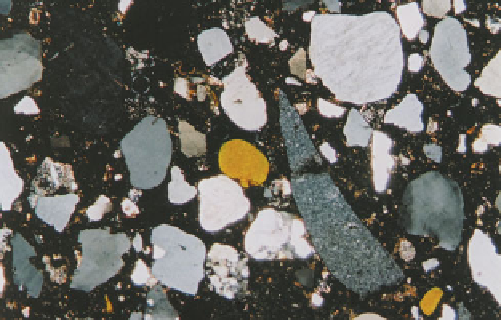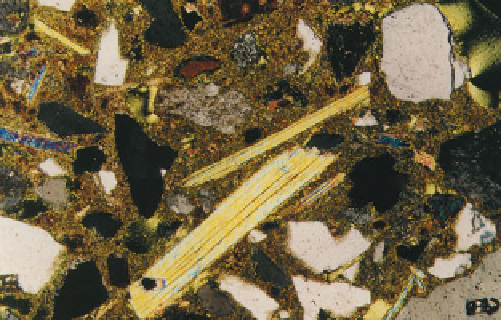Geoscience Reference
In-Depth Information
thickness, colour of aggregate/binder, and the relative
hardness and coherence of the material. High-power
examination of thin section specimens is then used to
determine the grading and mineralogy of the aggregate,
cement type, the presence of mineral additions/pigments,
assess the quality of workmanship, and screen the material
for evidence of distress or deterioration.
salts, or organic matter that may cause unsoundness. The
colour of the aggregate and, in particular, aggregate
particle coatings and fines may have a significant
influence of the overall colour of the hardened mortar.
Figure
311
shows a mortar that has been coloured pink by
iron oxides within the fine aggregate.
C
EMENT BINDER
Portland cement binders for mortars and renders have a
similar appearance in thin section to the cement matrix
of hardened concrete. Figure
309
shows a typical
uncarbonated Portland cement:sand mortar with an
isotropic matrix of calcium silicate hydrates including
dispersed portlandite (calcium hydroxide) crystallites
(first-order red and second-order blue interference
colours in cross-polarized light). Unhydrated/hemi-
hydrated cement grains are usually easy to observe in
plane-polarized light at magnifications of greater than
×100 (
312
). Observation of the phases present within
unhydrated cement grains enables identification of the
type of cement used. The size and spacing of relict
cement grains are a function of fineness of the ground
cement clinker, the W/C of the mix, and the degree of
hydration.
Portland cement:sand mixes tend to be rather harsh and
it is customary to use either lime or air-entraining agents
to add cohesion and aid workability. Figure
313
shows the
texture of an old Portland cement:lime:sand render. The
A
GGREGATE
The aggregates used for Portland cement-based masonry
mortars are usually uniformly graded with spherical,
rounded particles ('soft sand') to aid workability (
279
).
This contrasts with that preferred for external render
which should be well graded aggregate with irregular,
subangular particles ('sharp sand') to reduce drying
shrinkage (
280
). The aggregate grading, particle shape,
and surface texture are important factors affecting the
durability of the hardened mortar and these are assessed
in thin section by comparison with standard charts (e.g.
130
and
133
). Figure
309
shows the typical appearance
of Portland cement:sand mortar with a moderately well
graded, natural sand fine aggregate. The mineralogy of
the aggregate dictates the strength and soundness of the
aggregate particles. Aggregate may contain unacceptable
amounts of potentially deleterious materials, including
mica (
310
) or excessive fines, which may cause the mix to
be weaker than intended, by increasing the water demand.
Other undesirable aggregate constituents include pyrite,
309
310
309
General view of a Portland cement:sand mortar
from London, showing quartz (grey/white), flint (grey,
elongated), and glauconite (green/yellow) fine aggregate
particles (Thames Valley sand), bound by a matrix of
uncarbonated Portland-type cement (black). The cement
matrix exhibits a common abundance of portlandite
crystallites (brightly coloured 'specks'); XPT, ×35.
310
Portland cement:sand mortar from southwest
England, comprising crushed granite fine aggregate
consisting of angular quartz (white/grey/black),
feldspar (grey), and muscovite mica (bright green/blue
flakes) particles, bound by a matrix of carbonated
Portland-type cement (brown). Air voids are shown
dark green; XPT, ×75.






